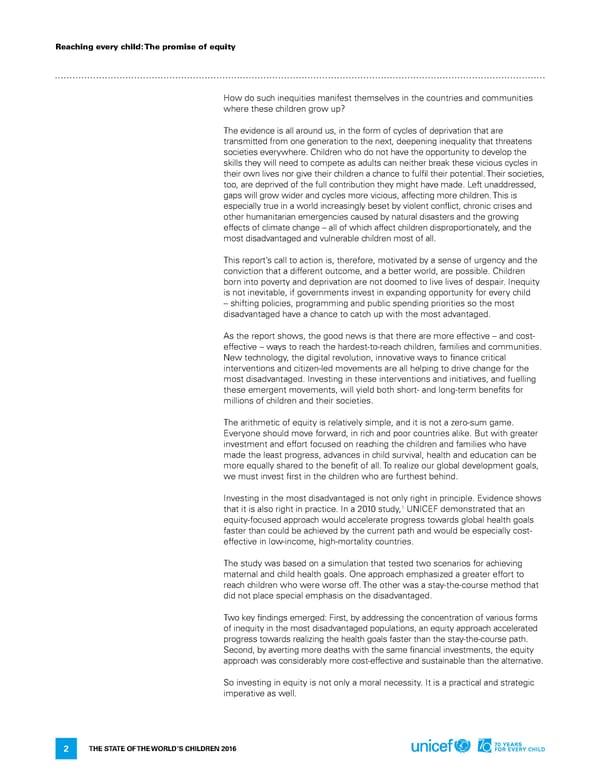Reaching every child: The promise of equity how do such inequities manifest themselves in the countries and communities where these children grow up? The evidence is all around us, in the form of cycles of deprivation that are transmitted from one generation to the next, deepening inequality that threatens societies everywhere. Children who do not have the opportunity to develop the skills they will need to compete as adults can neither break these vicious cycles in their own lives nor give their children a chance to fulfil their potential. Their societies, too, are deprived of the full contribution they might have made. left unaddressed, gaps will grow wider and cycles more vicious, affecting more children. This is especially true in a world increasingly beset by violent conflict, chronic crises and other humanitarian emergencies caused by natural disasters and the growing effects of climate change – all of which affect children disproportionately, and the most disadvantaged and vulnerable children most of all. This report’s call to action is, therefore, motivated by a sense of urgency and the conviction that a different outcome, and a better world, are possible. Children born into poverty and deprivation are not doomed to live lives of despair. inequity is not inevitable, if governments invest in expanding opportunity for every child – shifting policies, programming and public spending priorities so the most disadvantaged have a chance to catch up with the most advantaged. as the report shows, the good news is that there are more effective – and cost- effective – ways to reach the hardest-to-reach children, families and communities. new technology, the digital revolution, innovative ways to finance critical interventions and citizen-led movements are all helping to drive change for the most disadvantaged. investing in these interventions and initiatives, and fuelling these emergent movements, will yield both short- and long-term benefits for millions of children and their societies. The arithmetic of equity is relatively simple, and it is not a zero-sum game. everyone should move forward, in rich and poor countries alike. But with greater investment and effort focused on reaching the children and families who have made the least progress, advances in child survival, health and education can be more equally shared to the benefit of all. To realize our global development goals, we must invest first in the children who are furthest behind. investing in the most disadvantaged is not only right in principle. evidence shows that it is also right in practice. in a 2010 study,1 UniCef demonstrated that an equity-focused approach would accelerate progress towards global health goals faster than could be achieved by the current path and would be especially cost- effective in low-income, high-mortality countries. The study was based on a simulation that tested two scenarios for achieving maternal and child health goals. one approach emphasized a greater effort to reach children who were worse off. The other was a stay-the-course method that did not place special emphasis on the disadvantaged. Two key findings emerged: first, by addressing the concentration of various forms of inequity in the most disadvantaged populations, an equity approach accelerated progress towards realizing the health goals faster than the stay-the-course path. Second, by averting more deaths with the same financial investments, the equity approach was considerably more cost-effective and sustainable than the alternative. So investing in equity is not only a moral necessity. it is a practical and strategic imperative as well. The STaTe of The World’S Children 2016 2
 70 Years for Every Child Page 15 Page 17
70 Years for Every Child Page 15 Page 17